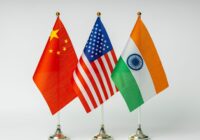[Here are Part 2 and Part 3 of this three-part series.]
China and India have many similarities. India has been shaped by Hinduism and China by Buddhism. Buddhism originated in India and has a similar value system to Hinduism. The roots of many systems considered Chinese are actually Indian, including martial arts, acupressure and acupuncture. China is also emerging as the new yoga superpower after the US. Logically, India and China should be friends, although China’s ambitions do not allow this.
India is a nuclear state with two nuclear-armed adversaries in China and Pakistan on its borders. China seeks to deepen economic relations with Pakistan via its Belt and Road Initiative (BRI). It has followed a “string of pearls” strategy to encircle India and makes constant revisionist claims about the India-China border.
Nevertheless, it is important to note that China had not supported Pakistan in the 1999 Kargil conflict. However, China’s assistance to Pakistan’s nuclear weapon and missile programmes, and its BRI investments in Pakistan threaten India. Therefore, India faces the risk of a two-front war.
A Power-Hungry China Seeks to Dominate India
China only respects hard power. Money and military might are the operative metrics. Beijing is seeking to wrest the mantle of global leadership from Washington. India has traditionally played a passive role with China. New Delhi has consistently demonstrated reluctance to confront Beijing or take the initiative of proposing new solutions to sort out its border disputes. Indian foreign policy, influenced by Hindu philosophy, including ahimsa, has traditionally seen leadership as an exercise of soft power, moral pressure, and diplomatic negotiations.
This soft “head-in-the-sand” foreign policy of unending talk and little action is further aggravated by India’s inability to reduce import dependence on Chinese electronics and pharmaceutical intermediates. Thus, China’s authoritarian regime believes that it has a free pass to bully India. The Chinese test this periodically through persistently revisionist border skirmishes and aggressive rhetoric in different forums.
Rising powers attempt to dominate their “near abroad” and this reflects clearly in China’s string of pearls, debt trap diplomacy and hexiao gongda—uniting with the small to counter the big—strategies. Jawaharlal Nehru, India’s first prime minister, came up with five Panchsheel principles, which included the principle of non-aggression. Yet the 1962 India-China War broke out at the height of Hindi-Chini bhai-bhai.
China has no problem with deception. Through the millennia, the Chinese have been guided by The Art of War, the classic penned by Sun Tzu in the 5th century BC. He argued that “warfare is a way of deception” and the 1962 war serves as a good example of the application of this principle. China uses Sun Tzu’s psychological techniques to achieve its political goals. In the case of Uyghur Muslims and Tibetans, China has practiced cultural genocide. China is aggressive, persistent, and unpredictable in its constant attempts to redraw the borders. Even 18 rounds of border negotiations with India have yielded no results.
China’s BRI initiative through Pakistan Occupied Kashmir (POK) to Gwadar port creates a super link through which military equipment can be moved. China is weaponizing BRI and this is detrimental to India. In a future scenario, Chinese military bases in the Indian Ocean Region (IOR) in Myanmar, Bangladesh, Sri Lanka, Maldives and Pakistan, acquired through debt trap diplomacy, would jeopardize Indian national security. Beijing is also cosying up with both Nepal and Afghanistan. In Nepal, China has had much success and the country even elected a communist government. In Afghanistan, success has been harder to come by because the Taliban runs a hardline Islamist regime.
India has to respond to Chinese aggression. It will only achieve peace when the country achieves adequate military and economic power. India could also turn to its very own political philosopher known as Chanakya or Kautilya who wrote Arthaśāstra in 300 BC.
Nuclear Pakistan’s Economic Woes Can Unleash Jihadism
The 1971 India-Pakistan War still scars the Pakistani psyche. India liberated Bangladesh, which until then was East Pakistan. Since then, Pakistan has been obsessed with India. As revenge it sought to “bleed India with a thousand cuts.” It funded and supported insurgencies in India. In Punjab, it led to a campaign of terror for Khalistan. Pakistan has always dreamt of annexing Kashmir and has persistently fomented trouble there since 1947. India and Pakistan have fought three major wars, one minor one and engaged in countless border clashes. So, a Pakistan-China nexus worries India.
Pakistan describes its friendship with China as being “higher than the mountains, deeper than the oceans, sweeter than honey.” Pakistan is the biggest recipient of BRI money. Chinese debt is $30 billion—30% of its external debt—and continues to grow. Because of this debt, Pakistan has lost its ability to be an independent voice for Muslims. Pakistanis speak about Kashmiris all the time but dare not mention fellow Muslim Uyghurs. So beholden is Islamabad to Beijing that Pakistan would have to follow China’s lead and could lead to a two-front war for India.
After years of military rule and a pseudo-democracy, Pakistan’s economy is in tatters. Both economic mismanagement and natural disasters have brought the country to its knees. The poverty rate has increased dramatically. Inflation has spiraled out of control. Thousands of madrassas have churned out tens of thousands of jihadis since the 1980s when Saudi money flooded into the country. Then, the goal was to fight the Soviets in Afghanistan. Now, jihadis could cause civil war and the implosion of Pakistan. Since Pakistan is a nuclear-armed state, an implosion poses tremendous security risks for India. Fostering a peaceful Jihadi-free Sufi-believing Pakistan is in India’s direct security interests.
India Must Heed Kautilya’s Wise Words
Kautilya recommends that states strive for a balance of power and prevent rivals from becoming too powerful. He asks the king to become the most powerful among his peers (vijigishu) to achieve peace and security. He includes conquest, psychological influence, physical domination, seduction and assassination as tools of state policy.
Kautilya also speaks of security alliances as a key tool of foreign policy. The combined military spending of Pakistan and China was $263 billion in 2020. This was nearly 3.6 times India’s defense budget. China alone outspends India by $180 billion. China spends less than 33% on personnel costs, while India spends about 60%. Hence, China can spend much more on modernization with better combat potential.
Needless to say, the Indian Army needs to focus on technology-driven modernization. Indian foreign policy wonks must deepen the country’s security arrangement with the US and Japan, which has just doubled its military spending.
The Chinese army has an edge over the Indian Army, but India is better prepared in high-altitude warfare and has more experienced troops. The Chinese air force is stronger than India’s in terms of fleet and strategic inventory, but India has more reliable platforms. China’s navy is the largest in the world. Its naval build-up outscores India’s by almost four times. The US still has the most advanced navy though. India needs closer naval ties with the US and greater expenditure on its navy.
India’s military spending of $76.6 billion is ranked third highest in the world after the US and China. It is one of the largest importers of arms. Indian armed forces are projected to spend around $130 billion in capital procurement from 2022 to 2027. Such large imports highlight repeated failures in indigenous defense production despite transfers of technology to the public sector companies. India must modernize and privatize this sector to lower its import bill and prepare better for war.
In Dec 2020, the government authorized the armed forces to raise their weapons and ammunition reserves so as to be able to sustain 15 days of high-intensity conflict. Until then, Indian forces could have only sustained such a conflict for ten days. Once, India’s reserves could sustain 40 days of war. This dropped to 20 days in 1999 and further dropped to 10 days. The current 15-day reserves must go back up to the 40-day mark.
In a nutshell, India has to build up its military strength again. It also has to embark on the Kautilyan exercise of developing alliances with countries wary of China. Not only the US and Japan but also Vietnam and Australia are potential partners. Peace will come only through strength, not supplication.
[Here are Part 2 and Part 3 of this three-part series.]
The views expressed in this article are the author’s own and do not necessarily reflect Fair Observer’s editorial policy.
Support Fair Observer
We rely on your support for our independence, diversity and quality.
For more than 10 years, Fair Observer has been free, fair and independent. No billionaire owns us, no advertisers control us. We are a reader-supported nonprofit. Unlike many other publications, we keep our content free for readers regardless of where they live or whether they can afford to pay. We have no paywalls and no ads.
In the post-truth era of fake news, echo chambers and filter bubbles, we publish a plurality of perspectives from around the world. Anyone can publish with us, but everyone goes through a rigorous editorial process. So, you get fact-checked, well-reasoned content instead of noise.
We publish 2,500+ voices from 90+ countries. We also conduct education and training programs
on subjects ranging from digital media and journalism to writing and critical thinking. This
doesn’t come cheap. Servers, editors, trainers and web developers cost
money.
Please consider supporting us on a regular basis as a recurring donor or a
sustaining member.
Will you support FO’s journalism?
We rely on your support for our independence, diversity and quality.








Comment